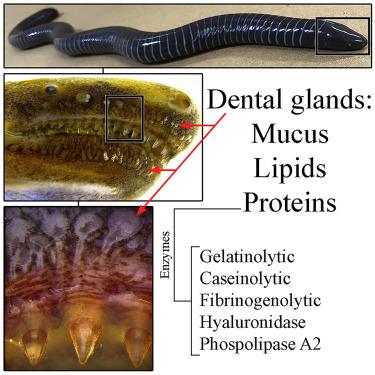iScience ( IF 4.6 ) Pub Date : 2020-07-03 , DOI: 10.1016/j.isci.2020.101234 Pedro Luiz Mailho-Fontana 1 , Marta Maria Antoniazzi 1 , Cesar Alexandre 1 , Daniel Carvalho Pimenta 2 , Juliana Mozer Sciani 3 , Edmund D Brodie 4 , Carlos Jared 1

|
Amphibians are known for their skin rich in glands containing toxins employed in passive chemical defense against predators, different from, for example, snakes that have active chemical defense, injecting their venom into the prey. Caecilians (Amphibia, Gymnophiona) are snake-shaped animals with fossorial habits, considered one of the least known vertebrate groups. We show here that amphibian caecilians, including species from the basal groups, besides having cutaneous poisonous glands as other amphibians do, possess specific glands at the base of the teeth that produce enzymes commonly found in venoms. Our analysis of the origin of these glands shows that they originate from the same tissue that gives rise to teeth, similar to the venom glands in reptiles. We speculate that caecilians might have independently developed mechanisms of production and injection of toxins early in their evolutionary history.
中文翻译:

凯西两栖动物口腔毒液系统的形态学证据。
两栖动物以其皮肤富含腺体而闻名,该腺体包含用于被动化学防御捕食者的毒素,例如,与具有主动化学防御作用的蛇不同,它们将毒液注入猎物。Caecilians(Amphibia,Gymnophiona)是具有附生习性的蛇形动物,被认为是鲜为人知的脊椎动物群体之一。我们在这里表明,两栖类盲肠动物,包括来自基群的物种,除了像其他两栖动物一样具有皮肤有毒的腺体外,在牙齿的根部还具有特定的腺体,这些腺体产生通常在毒液中发现的酶。我们对这些腺体起源的分析表明,它们起源于产生牙齿的相同组织,类似于爬行动物中的毒腺。









































 京公网安备 11010802027423号
京公网安备 11010802027423号